Our toolkit
This easily accessible toolkit gives you a guide, as well as tips and advice, on how to put the findings of the research carried out Frameworks Institute UK into action. It’s a step by step guide using our eight evidence-based framing recommendations. Together we can change the public perception of care experience by telling a new story, creating a new and compelling narrative.

A Quick Guide
How we talk about care experience matters.
Our research shows that people assume the care system is for damaged children. And that involvement with the care system makes things worse. To change these assumptions – and end the stigma against people with care experience – we need to tell a new story.
If you’re in a rush, or just need a refresh, you’re in the right place. You can also download this summary (pdf).
When talking about care experience...
Instead of...
Try...
Leading with the unique needs of children with care experience
Starting with what all children need to thrive
Only talking about harm caused by the care system
Talking about how our care system can – and should – support healthy development, now and in the future
Inadvertently implying the care system is ‘onesize- fits-all’ or that the care system is “standardised and cold”
Explaining the range of support our care system can provide, using the scaffolding metaphor
Sharing stories about parents making bad choices
Explaining how external factors can lead to involvement with the care system, using the navigating waters metaphor
Leading with - or asserting - stigma
Explaining how stigma works - and why it happens
Focusing on resilient individuals who fight and overcome hardship alone
Placing individual stories in context to show the supports that should be there for each and every child to thrive
Talking about the vulnerability of children and young people with care experience
Reminding people that our community ties are stronger when children get the support they need
Focusing on the scale and financial costs of failings in the care system
Showing how changing the care system is not just necessary, but within reach
Eight ways to talk about care experience in Scotland
1. Start with what all children need to thrive
Before
Our care system must meet the unique needs of Scotland’s most vulnerable children.
After
Our care system must provide the stable environments and loving, supportive, and enduring relationships that every child needs to thrive.
2. Link improvements to the care system to healthy development now and in future
Before
We need to improve Scotland’s care system before more children suffer lasting harm.
After
We need to improve Scotland’s care system so that each and every child can thrive.
3. Use the scaffolding metaphor to explain how our care system can and should support healthy development
Before
Our broken care system is failing children. It must provide intensive supports for every child.
After
Our care system must provide children with a strong foundation; with support that’s ready and responsive, when it is needed, for as long as it’s needed.
4. Use the navigating waters metaphor to explain how social and systemic factors can lead to involvement with the care system
Before
More and more children are being taken into care. This is a rising tide of parental neglect - and one of unprecedented proportions.
After
Scottish families are up against a rising tide of low wages and high costs. When so many families are struggling just to stay above water, it’s harder for parents to provide the best care.
5. If you need to talk about stigma, explain how it works and why it happens
Before
Stigma towards people with care experience is real and causes real harm. We need to end this stigma, right here and right now.
After
Books and TV shows are full of stereotypes about children in care - and this influences how we think, without us realising. We need a new story.
6. Place individual stories in context to show how - with the right support - every child with care experience can thrive
Before
Sean fought hard to overcome his difficult childhood and early trauma. His story reminds us that every child with care experience can succeed in later life.
After
Sean got the support he needed, when he needed it. Our care system must make sure that every child like Sean has the opportunities they need to thrive.
7. Use the value of strengthening community ties to remind people that our communities are stronger when every child has what they need
Before
Failings in the children’s care system let down Scottish families.
After
Improvements in the children’s care system will strengthen our communities.
8. Show that change is possible, as well as necessary, to build support for solutions
Before
Childhoods are being lost to a broken care system. Entering care means subjecting children to a lifetime of disadvantage, stigma and hardship. It urgently needs reform - before it’s too late.
After
Children’s care urgently needs reform. Because when we get it right - with stable homes, enduring, loving relationships, and services to address early trauma - our care system can be the foundation every child needs to thrive.
Making change.
How we talk about care experience matters.
We know from our research that people have a fatalistic approach to care and people with experience of care – a broken system that causes more damage, damage that can be undone. To change these assumptions and end the stigma against people with care experience – we need to tell a new story.
One that shows what can and must change so that each and every child with experience of care can thrive.
What is framing and why does it matter?
Framing an issue effectively means doing things a little differently to standard awareness raising or campaigning.
To frame an issue, we need to:
- Know what we’re communicating in to by understanding how people think and feel about this issue.
- Make deliberate choices when presenting information and telling our stories.
- Trigger certain ways of thinking and avoid others – it’s very hard to argue against a feeling or belief once it’s activated.
- Show why it matters by aligning solutions with people’s ideals of what’s desirable and good.
- Show that change is possible, not that problems are huge and challenging.
- Give your audience ways to think differently instead of meeting them where they are.
Why do we need to frame care experience?
- Forever damaged: children who enter the care system suffer irreversible harm
- The care system is standardised and cold: the care system can’t provide what children need for healthy development, which makes this damage worse
- Selfish parents: children are taken into care when selfish parents make bad choices
- Fatalism: nothing can be done to improve care experience; you can’t change human nature - or fix a broken system.
Together, these lead people to think about care experience in narrow and stigmatising ways. To overlook the potential of wider, systemic change and dismiss people with experience of care as broken products of a broken system.
To end the stigma against people with experience of care – and build support for reform – we have to change how people think about the care system. And what it can and should do for Scottish children.
How should we frame care experience?
We can change people’s assumptions about care experience with a new story. A story focused on what each and every child needs to thrive. This means we:
- Make children's care about what all children need to thrive – now and in future
- Explain the context and conditions that shape care experience – and we how can shape them to help children thrive
- Remind people what our communities are stronger when every child has what they need - and vice versa
If and when speaking directly with or about a person with experience of care, it is always best to ask the person which term they prefer to use when referring to their experience.
A note about the examples in this toolkit: care experience takes many forms. We’ve only shared a few examples here – please use your own, and let us know others we should add.
Make this about what all children need to thrive
Tip
With a story about what all children need - rather than vulnerability, or unique needs - we reduce othering and stigma. And build support for improving the care system.
Tip
Use terms like ‘can’ and ‘should’ rather than ‘will’ when talking about the care system’s ability to meet children’s needs. This avoids fatalism (the idea that nothing can be done) and being seen as unrealistic.
Like this
“All children need the same things to thrive: a stable home, strong support and steady, loving relationships. This new programme means our care system can provide this for each and every child in Scotland.”
Not like this
“Children in care are Scotland’s most vulnerable children: stigmatised, traumatised and separated from family. This new programme means the care system can meet the unique needs of every child in care.”
Here’s what this could look like in a fostering campaign
Before
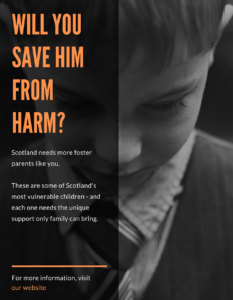
After
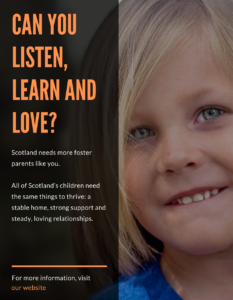
Link improvements to the care system to healthy development now and in future
Make the case for action about setting children up to thrive throughout their lives. Rather than preventing further harm.
This helps people see the need for change without drawing attention to damage or difference - and making stigma worse.
Tip
With a story about what all children need - rather than vulnerability, or unique needs - we reduce othering and stigma. And build support for improving the care system.
Tip
Use terms like ‘can’ and ‘should’ rather than ‘will’ when talking about the care system’s ability to meet children’s needs. This avoids fatalism (the idea that nothing can be done) and being seen as unrealistic.
Make the case for action about setting children up to thrive throughout their lives. Rather than preventing further harm.
This helps people see the need for change without drawing attention to damage or difference - and making stigma worse.
Like this
“We need to improve Scotland’s care system so that each and every child can flourish. When we get it right, children have more options: they can do well in school, have good mental health, and succeed at work. We need to make changes so that all of Scotland’s young people have opportunities to thrive.”
Not like this
“We need to improve Scotland’s care system before more children are harmed. When we get it wrong, children suffer a lifetime of disadvantage: they’re more likely to do badly in school, face mental illness, and experience chronic unemployment. We need to make changes before more of Scotland’s young people are put at risk.”
Here’s what this could look like in a fostering campaign
Before
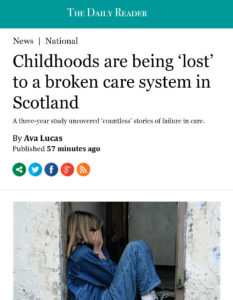
After
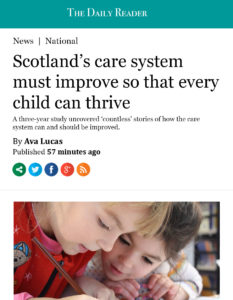
Use metaphors to expose and explain systems at work
We can use metaphors to explain how systems and circumstances can shape our lives. And how we can - and should - shape those systems to meet our needs.
Tip
Metaphors bring complicated concepts to life, without dumbing down. When we explain - and not just assert - why something is needed, we increase people’s understanding and support for action.
Use scaffolding to explain the range of different supports an effective care system can provide.
Like this
“Stable homes and loving relationships are the foundation every child needs to thrive. Our care system can provide this and more. Done right, we can be the scaffolding that helps children build their lives - providing stability as and when they need it. From building their first language skills, to getting their own home.”
Not like this
“Our care system must provide intensive services for children. Children in care need targeted intervention, life skills, and counselling to address the unique traumas they have experienced. Without the support of the care system, children are left to fall through the cracks of society and suffer even more harm.”
To use this metaphor, call to mind a flexible structure that:
- Has different parts that work together to provide support and opportunities
- Is there to support development where it’s needed - and not restrict or control
- Is ultimately build by people who have a stake in that development.
Here’s what this could look like in a website article
Before
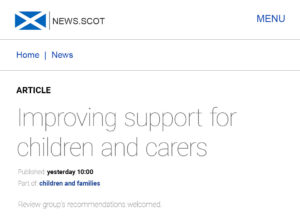
After
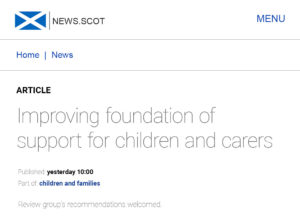
Use navigating waters to show how social and economic factors can make it harder for parents to care for children. And to explain the value of upstream support for struggling families.
Navigating waters extends the currents metaphor (pdf, page 10) in FrameWorks' framing poverty work.
Like this
“Scottish families are up against a rising tide of low wages and high costs. When you’re struggling to stay afloat, it’s harder to provide the best care. Programmes like [name] are safe harbours that help families through tough times - and make sure that every child has what they need.”
Not like this
“More families are neglecting their children than ever before. This is a rising tide of parental neglect in Scotland and our children are paying the price. Programmes like [name] provide much needed support for families - and make sure that fewer children are taken into care.”
To use this metaphor, call to mind external forces that:
- Act on people in ways they cannot control
- Make it harder to navigate life’s challenges
- If left unchecked, could overwhelm more families
- Could be lessened upstream, with the right support.
Here’s what this could look like in a news story
Before

After
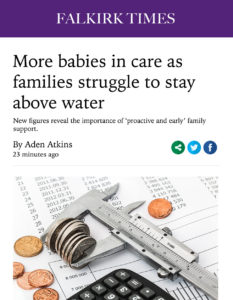
If you need to talk about stigma, explain how it works
Stigma is an extra challenge for people with care experience. Our research has shown that is really hard to have conversations about stigma without making it worse. Most people don’t believe that stigma still exists. Or if it does, that it’s part of human nature and can’t be changed.
Because of this, starting our story with stigma – or an assertion that stigma exists – is likely to backfire and to make that stigma worse for other people with care experience.
All of the recommendations in this toolkit are designed – and tested – to reduce stigma. Without using the term.
If we do need to talk about stigma, our words are less likely to backfire if we explain how stigma works. And why it happens in the first place.
Tip
Name the sources of stigma: representations of people with care experience in media, TV, news coverage, radio. This helps us avoid fatalism (the idea that nothing can be done) - and individual blame.
Like this
“Our media keeps showing stereotypes of children in care as lost causes. This affects our attitudes and behaviours, in ways we don’t even realise. This is stigma - and it affects people with care experience in all areas of life. It’s time to change the story.”
Not like this
“Stigma exists, and it follows people with care experience throughout their lives. The consequences are profound - and tragic. We must put an end to this stigma now.”
Place individual stories in context to bring systemic factors to light
Our stories are powerful. But if we only tell stories that focus on individuals, with individual hardships and triumphs, we narrow people’s understanding of care experience. And direct their attention away from the wider systems and conditions that need to change.
We can add context to individual stories to show that we need to improve systems and conditions, not people. To make sure our stories aren’t dismissed as exceptional or rare. And to show how - with the right support - every child with experience of care can thrive.
This is not about holding back our stories. This is about making sure our stories are heard - and make the change we want to see.
Like this
“I worked hard to be where I am today. But I also had support when I needed it - from people at home, to teachers at school. People who gave me stability while I forged my own path. Everyone’s experience of care is different; but everyone who comes through the care system needs that same stability.”
Not like this
“I worked hard to be where I am today. I had to fight to overcome my difficult childhood. I had to forge my own path. And if I can do it, so can everyone who comes up and through the care system.”
A few phrases that bring in context
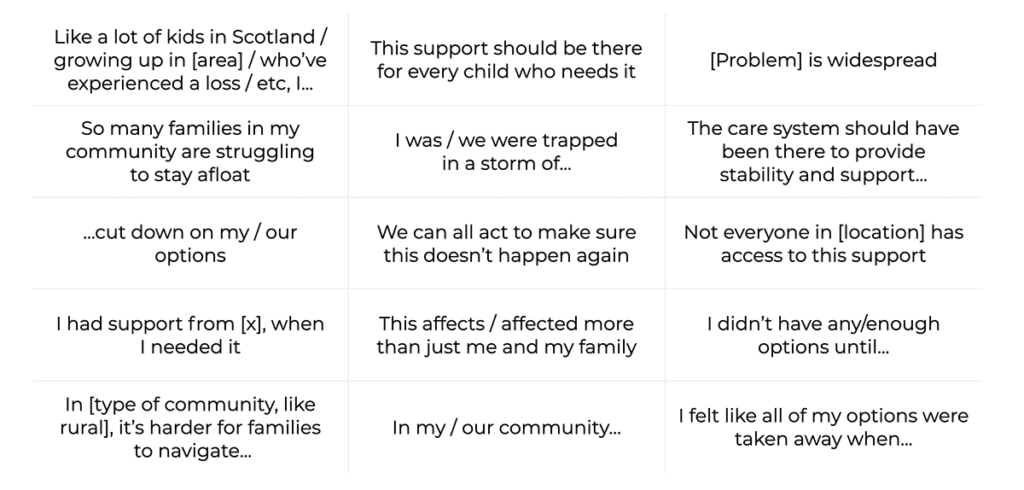
Use values to remind people why improving care experience matters
We use values frames to state powerful, unarguable truths about our world. To state that our communities are stronger when every child has what they need to thrive. And to establish our common grounds for action - without lecturing, othering, or talking down.
Tip
Use an inclusive ‘we’ - one that refers to everyone, not just your group or organisation. This increases people’s belief that they can work together to make a difference.
When we frame care experience as something that matters to all of us, we reduce othering. And help people see their role in creating change.
Use the value of strengthening community ties to remind people that the right support for children in care helps bring our communities back together.
Like this
“Our communities are stronger when every child has what they need to be healthy, and to thrive. Yet right now, many children with care experience don’t get the right support - and are left feeling isolated and excluded. We need to strengthen our children’s care system and bring our society together.”
Not like this
“The care system is struggling to cope. Right now, far too many children are not getting the right support. They’re left isolated and excluded. We need to strengthen our children’s care system because these improvements are so desperately needed.”
To use this values frame:
- Focus on our shared responsibility to build and maintain our communities
- Emphasise that, over time, our community ties have weakened - and this is partly because of how people with care experience are treated
- Remind people that we can strengthen our communities by making sure that each and every member gets the support they need.
Here’s what this could look like in a news story
Before
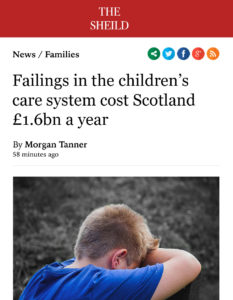
After

Show that change is both necessary and possible
Problems with the care system can sometimes seem overwhelming. We can tackle this by balancing urgency ‘we must improve care’ and efficacy ‘we can improve care.’
This means sharing specific, tangible ways to improve care experience. And explaining how these solutions help children in Scotland to thrive.
Tip
Use the scaffolding metaphor to explain how the care system can support children as and when they need it. Use navigating waters to explain the role - and importance of - upstream, preventive solutions.
Tip
Talk about how things ‘could’ and ‘should’ be in calls to action. This holds the current system to account without activating fatalism. Or undermining the need for systems of support to begin with.
Like this
“Scotland’s care system needs urgent reform. Because with more of the right support - like family support and services to address early trauma - we can provide the stable foundation every child needs.”
Not like this
“Scotland’s care system is broken. Entering care condemns children to a lifetime of disadvantage; leaving them vulnerable, stigmatised and alone. This crisis must end before even more children suffer lasting harm.”
A how-to guide.
Changing hearts and minds takes time.
Together, we need to tell lots of well-framed stories - in different ways, and reaching different people. Below are a few ways to help us tell different kinds of stories: from sharing our own experiences or campaigning for change, to our everyday conversations or raising funds.It can be tricky if you’re new to framing.
If you’d like more support, get in touch.
How can we frame for different aims and audiences?
1.
When making a policy or programmes ask
- Focus on what all children need to thrive before positioning the care system as one way to meet those needs
- Talk about how support systems can and should be improved to meet children’s needs
- Use strengthening community ties to remind people that our communities are stronger when each and every member of that community has what they need.
2.
When recruiting for professionals
- Use the scaffolding metaphor to tie specific support opportunities to the wider care system
- Extend the navigating waters metaphor to show how services can act to help families navigate tough times
- Use individual stories in context to talk about the difference professionals have made in people’s lives.
3.
When recruiting for carers and volunteers
- Dial up the human aspect of the scaffolding metaphor. Carers and volunteers can help build and connect that scaffolding
- Use strengthening community ties to remind people that our communities are stronger when each and every member of that community can take part in it
- Don’t exceptionalise the need for support - or use ‘saviours and victims’ narratives that can worsen stigma
4.
When providing guidance or talking about preventive support for families
- Normalise the support, not the struggle. Start with solutions
- Use and extend the navigating waters metaphor to show how people and services can act to help families navigate through tough times
- Avoid reinforcing the harmful beliefs that people hold about selfish parents and individual blame.
5.
When writing longer content
- Extend the scaffolding or navigating waters metaphors throughout your piece; but try not to mix or use them in confusing ways
- Bring in the currents metaphor to talk about poverty as one of many external factors that can make life harder to navigate
- Sharpen focus on context and surroundings with pictures and illustrations that show connections, barriers and supports.
6.
When making a fundraising ask
- Make this about what the funding is ultimately for: healthy and thriving children
- Talk about the potential of all children - to thrive, and take part in our communities - when their developmental needs are met
- Celebrate successes; of people with the care experience, and of the support that helped
- Avoid leading with vulnerability or activating the idea that children in care are forever damaged.
7.
When choosing images
- Use images that are aspirational, active and include a range of different people
- Show groups of people interacting with each other and their environment to strengthen community ties
- Try to avoid images of individuals in crisis that might reinforce the assumptions that people hold about care experience - in particular, that children with care experience are forever damaged.
How can we frame with different tones?
We can adapt tone to purpose by changing our levels of stridency and force. Dial it up and down as you need to.
Like this, using the value of strengthening community ties

Tip
We can also dial up or down the scale of an identified problem. A call to help “families being dragged under” indicates a bigger challenge than one to help “families finding it harder to navigate.”
How can we frame with different channels?
Media interviews
Interviewers can activate harmful assumptions with the questions they ask. We can disrupt these assumptions with ‘spot, position and move.’
- Spot the harmful beliefs that might be activated by a question
- Position yourself to move away from those beliefs - with a bridging phrase, or by picking up on an aspect of the question that’s helpful
- Move with a reframed answer that responds to those harmful beliefs.
We can also incorporate framing recommendations into spokespeople briefings and key messages. If you’d like more information and support, get in touch.
Here’s what this could look like in practice
Q Every child needs care - and that’s something only parents can provide. How can the care system properly look after Scotland’s kids? Parents need to step up. It’s just one trauma after another.
Tip
Spot - this question furthers the idea that involvement with the care system forever damages children. And that this happens when selfish parents make bad choices.
Like this
A Every child needs the same things to thrive: a stable home and steady, loving relationships. Scotland’s care system is just one way for our communities to step up and make sure that every child gets what they need. And this means helping parents and families who are struggling to stay above water.
Not like this
A There’s no replacement for a parent’s love. We’re working hard to make sure our care system can come close - and to help children recover from the trauma of family separation. Where we can, we make sure that people get help to be better parents before their children are taken away.
Tip
Metaphors trigger strong mental images - so journalists will often pull them into article headlines.
Social media
We’ve used fake social media accounts for these - let us know if you have any more examples for us to add.
Here’s what this could look like in practice
Harness existing conventions on instagram with framed images, stories in context and inspiring quotes:
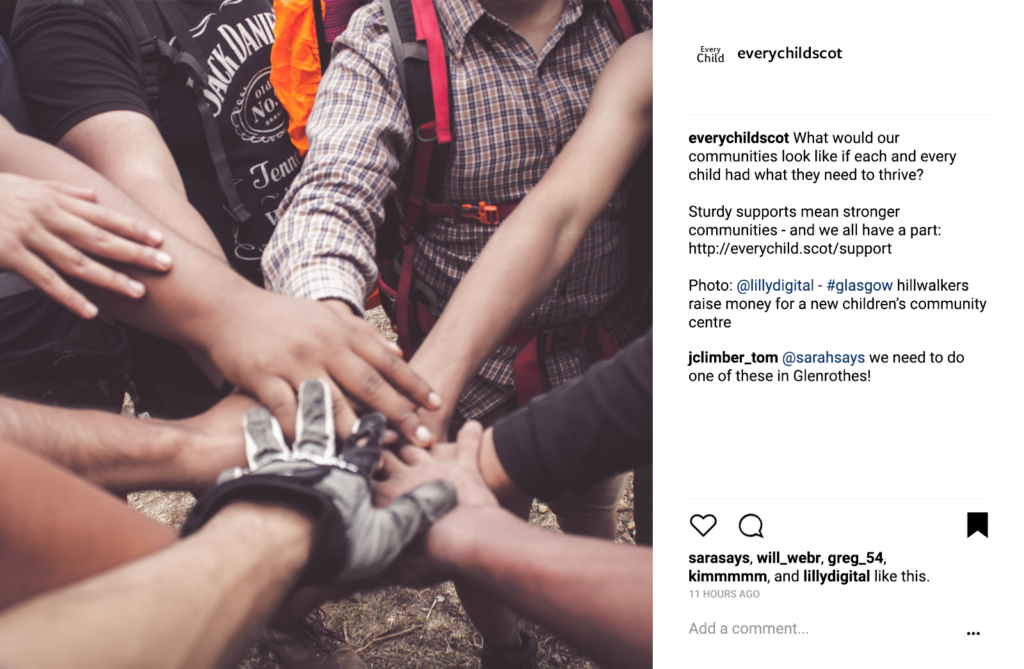
Drive site visits and tap into existing conversations:
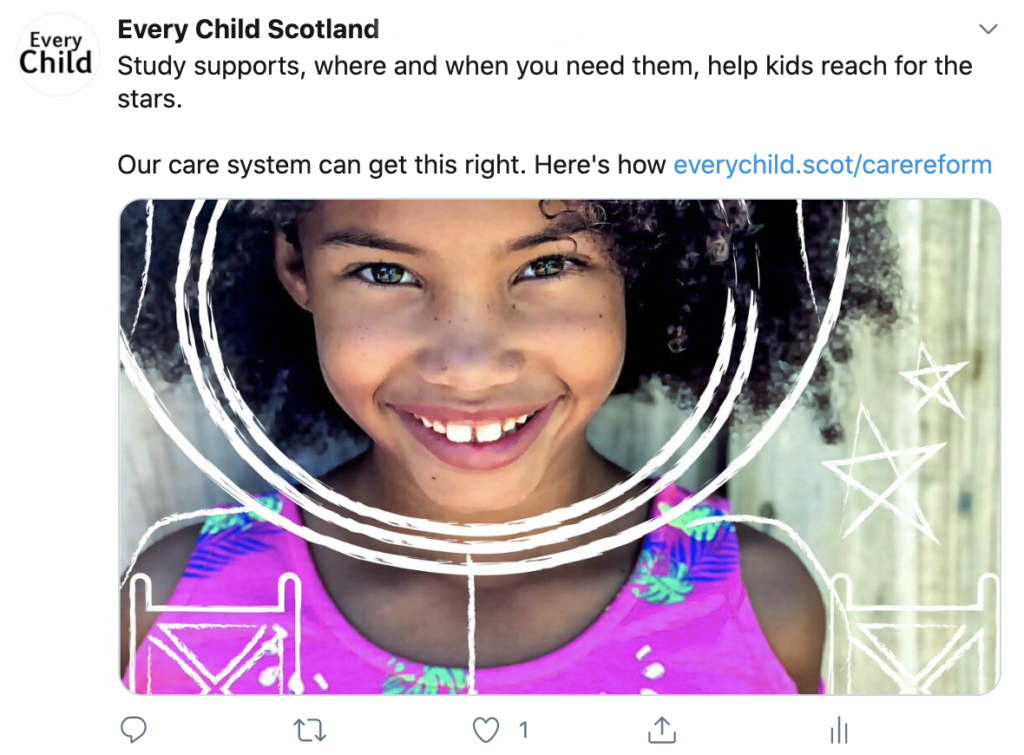
Share stories (with context) that tie into policy and programme needs:
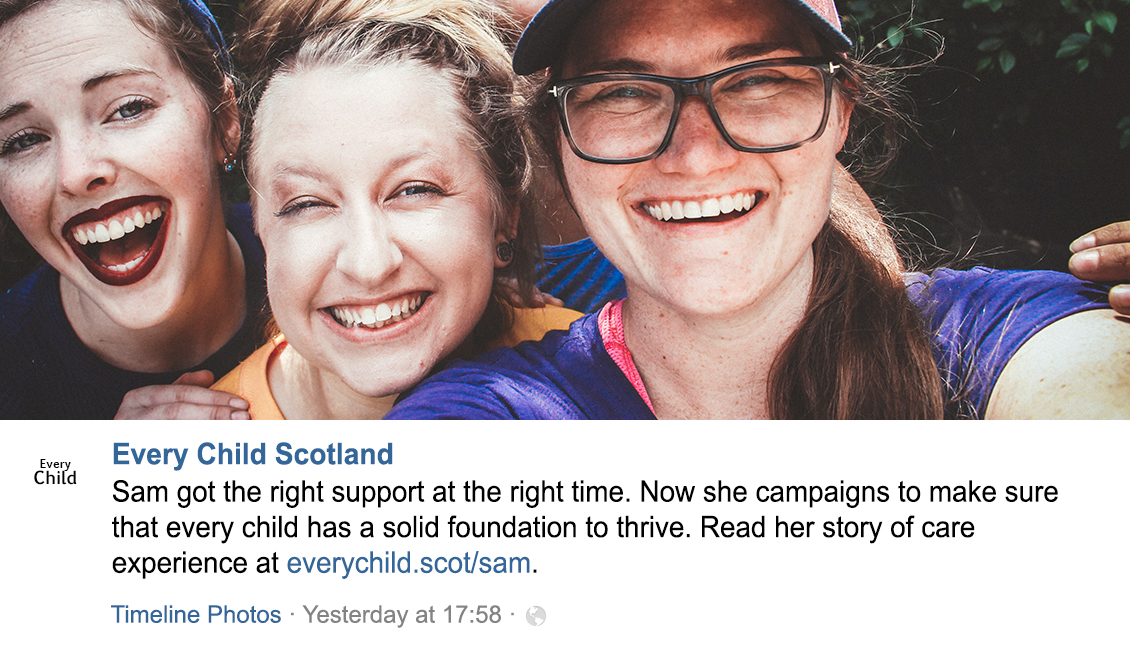
Google Ads
Drive site visits to specific landing pages:

